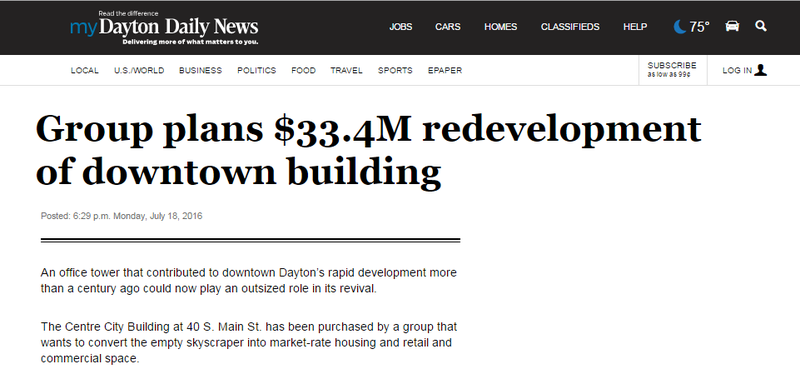An office tower that contributed to downtown Dayton’s rapid development more than a century ago could now play an outsized role in its revival.
The Centre City Building at 40 S. Main St. has been purchased by a group that wants to convert the empty skyscraper into market-rate housing and retail and commercial space.
The $33.4 million historic reuse project would help activate an area of downtown that may be on the verge of a comeback since fundraising efforts are far along to construct a new music pavilion just across the street.
“The redevelopment of the Centre City building is important for a variety of reasons, among them the redevelopment of a vacant building, the preservation of an architectural resource and the adding housing units to the downtown core,” said Tony Kroeger, city of Dayton planner.
Centre City Partners LP spent nearly $1.7 million to purchase the 21-story Centre City building from Centre City Group LLC, which bought the property for $450,000 in 2009.
The limited partnership was incorporated in April 2015 by First Developers LLC in Virginia. The group has been working to acquire the office tower since last year, officials said.
The building’s “acquisition and proposed redevelopment strategy is a sign of confidence in downtown, and we feel that confidence is justified,” said Kroeger.
The plan for the property is 166 market-rate apartments, including a mix of studios and one- and two-bedroom units, and a single three-bedroom unit at the top of the office tower, said Paul Ruby, a member of First Developers.
Retail and restaurant spaces are planned for the ground level and possibly could include a deli or fast-causal establishment, Ruby said.
Construction on the project hopefully could begin next year, and should take about 16 months to finish, he said.
The project would breathe new life into a historically rich building that has fallen on hard times in recent years.
The office tower — which typifies Chicago commercial style — was built beginning in 1904 and remained Dayton’s tallest structure until the construction of the Kettering Tower in 1970.
The Centre City building supported office and retail development in the heart of the Central Business District at a time when U.S. urban areas were benefiting from a real estate boom, according to a 1993 nomination application for national historic designation.
The Centre City property became the tallest reinforced concrete building in the world after a seven-story tower addition was completed around 1924. However, many taller buildings have been constructed since that time.
Developers plan to pursue state and federal historic tax credits.
Though the state credits are competitive, developers believe their project and the building are deserving of an award. Also, history may be on their side.
A previous proposal to adaptively reuse the Centre City building was awarded $1.87 million in state historic tax credits in 2011. Later on, developers reapplied for and received a larger award.
But today, the building does not have an active award. Previous credits were returned to the state after the proposal failed to move forward.
But Dayton’s economy is in better shape than it was several years ago, and the downtown housing market has been very strong.
The Centre City building is located across from Dave Hall Plaza, which is the proposed site of the new Levitt Pavilion Dayton. The project would create a free, outdoor music venue that hosts 50 concerts each year.
Fundraising is underway to help finance construction on the music venue, with much of the funding already secured.
Pavilions in other communities have provided an economic boost to the surrounding areas, supporting retail and other kinds of developments. City officials say the pavilion would be a downtown anchor and one-of-a-kind destination.
Centre City Partners may also pursue clean-energy tax credits and other types of grants or incentives.
But notably, the limited partnership also will use about $6.5 million in EB-5 capital to help fund the historic rehabilitation, Ruby said. He said nearly all of the EB-5 funding has been raised.
EB-5 projects are through a federal immigrant investor program, which is designed to boost local economies, especially in blighted areas.
Under the program, foreign investors are directly eligible to receive green cards if they contribute at least $500,000 to a U.S. business venture that preserves or creates new jobs.
First Developers LLC consists of members of American Investor Immigration Funds (AII), a Virginia-based firm that specializes in EB-5 development. Ruby is the vice president of AII.
Since 2008, members of the firm have been responsible for more than $1.2 billion in development, which included $250 million in EB-5 capital, according to the AII website.
Ruby said his firm has completed a variety of similar historic projects, that tend to be in the $20 million to $50 million range.
“We have a track record I’m confident in, and I think we’ll be able to pull everything together,” he said.
Mentions
States
- Virginia
Videos





Subscribe for News
Site Digest
Join Professionals on EB5Projects.com →
Securities Disclaimer
This website is for informational purposes only and does not constitute an offer or solicitation to sell shares or securities. Any such offer or solicitation will be made only by means of an investment's confidential Offering Memorandum and in accordance with the terms of all applicable securities and other laws. This website does not constitute or form part of, and should not be construed as, any offer for sale or subscription of, or any invitation to offer to buy or subscribe for, any securities, nor should it or any part of it form the basis of, or be relied on in any connection with, any contract or commitment whatsoever. EB5Projects.com LLC and its affiliates expressly disclaim any and all responsibility for any direct or consequential loss or damage of any kind whatsoever arising directly or indirectly from: (i) reliance on any information contained in the website, (ii) any error, omission or inaccuracy in any such information or (iii) any action resulting therefrom.



